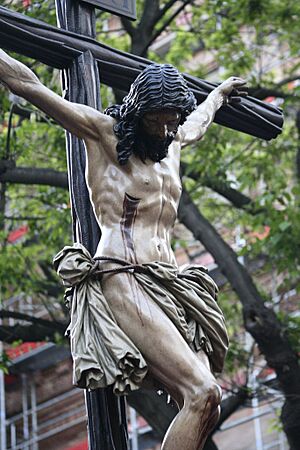Juan de Mesa facts for kids
Juan de Mesa y Velasco (born 1583 – died 1627) was a Spanish artist who made sculptures during the Baroque period. He created many important statues, called effigies, which are still used in special parades during Holy Week in Seville.
About Juan de Mesa
Juan de Mesa was born in Córdoba. He was baptized on June 26, 1583. When he was older, he moved to Seville in 1606. There, he joined the art studio of a famous sculptor named Juan Martínez Montañés.
De Mesa passed away in Seville in 1627. He died quite young. Because of this, and because we don't know much about his life, some people think he might have been sick for a long time.
His Artistic Style
Juan de Mesa's sculptures were very realistic. This means they looked a lot like real people. He learned this style from his teacher, Montañés.
At that time, the Catholic Church wanted art to be easy for everyone to understand. They wanted sculptures to show real human feelings and forms. This way, people could connect with the art and its message more easily. De Mesa's realistic style fit perfectly with this idea.
Famous Sculptures
Most of Juan de Mesa's surviving works are large statues made for religious parades. These statues are still very important to people today. Some of his most famous works include:
- Cristo del Amor (Christ of Love)
- Cristo de la Buena Muerte (Christ of the Good Death)
- Jesus del Gran Poder (Jesus of Great Power)
See also
 In Spanish: Juan de Mesa para niños
In Spanish: Juan de Mesa para niños
- Sevillian school of sculpture


